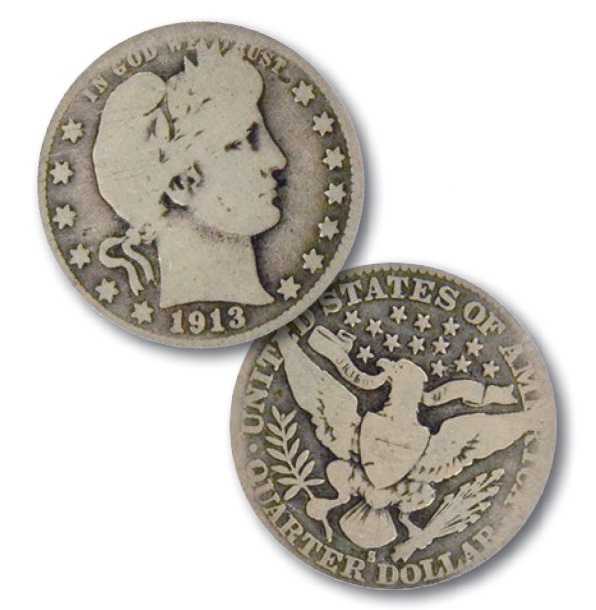A thought for your pennies
Drs. Wilfred T. Tysoe & Nicholas D. Spencer | TLT Cutting Edge April 2017
The wear rate of coins increases with time in circulation—why?

Lot 315B, 1913 S. Barber Quarter Dollar, Gulfcoast Coin and Jewelry (May 2015).
REMOVING PART OF A COIN AND PASSING IT OFF AT FACE VALUE used to be a lucrative crime, since coins were once made of precious metals. In London in 1690, for example, Thomas and Anne Rogers were executed in gruesome fashion for “clipping” the edges off 40 pieces of silver (
1). An alternative to clipping was “sweating,” which involved shaking coins in a bag and collecting the precious wear particles that were generated. This, of course, is a tribological phenomenon that not only occurs as a result of criminal intent but is currently taking place innocently in our pockets, albeit at a lower rate.
Edward Allen—Emeritus Professor of Mathematics at Texas Tech University, in Lubbock, Texas—has been giving some thought to the wear processes taking place on coins in circulation (
2). The principal assumption in Dr. Allen’s work is that the coin is being worn (by rubbing, rather than corrosion, flattening or marring) at two different rates, since the higher regions are protecting the lower regions from contact. Based on this, he could derive a stochastic differential equation, involving the assumption of Archard that γ, the coin-thickness loss, can be expressed as:
γ = CFL/H
where
F is a normal force on the coin surface,
L is a sliding distance of the force (across the surface),
H is the hardness of the coin material, and
C is a constant depending on conditions of coin circulation. In order to introduce the time factor,
b is defined as the rate at which the force is applied to the surface to lead to a decrease by γ, i.e., the number of times per day, for example, that the coin decreases in thickness by γ. The rate of change of thickness is then equal to
bγ, which is the wear rate and
bγ = K/H
This immediately tells us that harder coins are going to last longer! For a totally flat coin, a stochastic differential equation can be constructed of the form
dh(t) = -c dt + β dW(t)
where
h(t) is the coin thickness,
c = bγ = K/H, and
β dW(t) is a term that derives from the standard Wiener (or Brownian Motion) process, where
β = √(γ 2b) = K/(H√b).
The solutions to the equation yield thickness values with time that can be readily (via density) converted into mass loss.
The next step is the incorporation of the two-level relief of the coin into the model using the assumption that high regions wear faster than low regions, such that the wear rate scales with the difference in the heights. This also can be thought of as the normal force (in the Archard equation) scaling with the height difference. The result is that, in the two-level system, the wear rate increases with time as the shadowing effect of the higher level becomes less significant as it is worn away. A quantitative measure for coin wear is the ratio of current mass to initial mass, although this is only useful once the mass loss is significantly greater than the variability in the mass of the minted coins, which can be around ±0.5%!
These results are interesting for a number of reasons. First, understanding how to prolong the life of coins is obviously of interest to government mints, since longer circulation life leads to cost savings. Second, there is an interest among numismatists in being able to quantify the condition of coins, and this would most easily be performed by weighing them. Third, the approach developed for coins could potentially be applied to other wearing tribological systems, such as tires or tribofilms.
FURTHER READING
1.
The Proceedings of the Old Bailey (ref. t16901015-36). Available at
www.oldbaileyonline.org/browse.jsp?div=t16901015-36.
2.
Allen, E. (2016), “Stochastic differential equation models for the wear of coins in circulation,”
Trib. Lett. 64: 45.
 Eddy Tysoe is a distinguished professor of physical chemistry at the University of Wisconsin-Milwaukee. You can reach him at wtt@uwm.edu
Eddy Tysoe is a distinguished professor of physical chemistry at the University of Wisconsin-Milwaukee. You can reach him at wtt@uwm.edu.
Nic Spencer is professor of surface science and technology at the ETH Zurich, Switzerland. You can reach him at nspencer@ethz.ch.
Both serve as editors-in-chief of STLE-affiliated Tribology Letters journal.